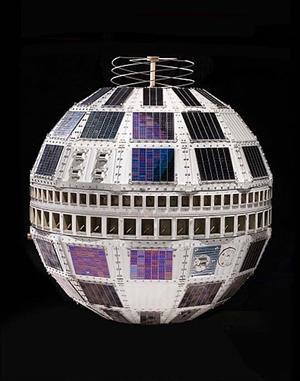On July 23, 1962, the Telstar satellite relays the word's first exchange of live television shows by Europe and the United States. Included in the 20-minute broadcast are live images broadcast from the Seattle World's Fair. It is estimated that more than 200 million viewers on both sides of the Atlantic watch this historic telecast.
A New Era of Communication
Telstar 1 was built by AT&T at Bell Telephone Laboratories, and was launched on July 10, 1962. The satellite was the first privately sponsored space launch at Cape Canaveral. Telstar 1 was a 34.5-inch-diameter sphere that weighed over 170 pounds and was powered in space by solar panels.
On the day of the launch, a brief test was made of the satellite's transmission capabilities. During its sixth orbit, television images of a flag outside the Andover Earth Station -- the United States ground station in Andover, Maine -- were relayed to the Pleumeur-Bodou station in northwestern France. The television image was accompanied a recording of America the Beautiful and The Star Spangled Banner.
Unlike NASA’s Echo satellite, which was launched in 1960 and only acted as a passive reflector of radio signals, Telstar was first communications satellite that could actively direct and amplify telephone calls. Hours after Telstar’s launch, one of the first long-distance phone calls in space-age history took place between Senator Warren Magnuson (1905-1989) in Washington D.C., and Governor Albert Rosellini (1910-2011) and Seattle World's Fair general manager Ewen Dingwall (1913-1996) atop the Space Needle.
Fairgoers listened in on the six-minute conversation over the fair’s public address system, as Rosellini greeted Magnuson and thanked NASA and AT&T for launching the historic satellite. Ewen Dingwall got on the line next, and was clearly excited by the clarity of Magnuson’s voice. Dingwall exclaimed, “Senator, you sound as though you’re calling from the foot of the Space Needle, instead of back in Washington D.C. This is what you call a good connection. I think it is astounding” (Seattle Post-Intelligencer, July 11, 1962). Even after they hung up, Dingwall continued to marvel at the quality of the reception.
Live from Seattle
On July 23, the Telstar satellite made history again when the United States and Europe exchanged planned television programs for the first time. The 20-minute “America to Europe” program included live broadcasts of a Cubs-Phillies baseball game, Colonel John Glenn speaking from Cape Canaveral, a crowded Detroit expressway, a view of Mount Rushmore, and best of all for those in Seattle -- scenes of Century 21.
Century 21 received 90 seconds of air time, broadcasting sights and sounds from around the fair. A panoramic view from atop the Space Needle came first, followed by glimpses of Japanese Bon Odori, Spanish Flamenco, and Hawaiian Hula dancers. European viewers also saw a Pedicab in action, as well as a young boy enjoying a Belgian Waffle.
KING-5 TV was chosen to represent all Pacific Northwest networks and Charles Herring was the announcer for the Seattle segment. The television station used six cameras, three mobile units and a crew of 35 to create the segment.
Televisions were set up throughout the grounds, so that fairgoers could watch both the American and European broadcasts. In Europe, 54 cameras broadcast scenes from Austria, Britain, France, Germany, Italy, Sweden, Switzerland, Yugoslavia, and the Vatican, and included views of the Eiffel Tower, the Coliseum, Big Ben, and more. The last minute of the broadcast was cut off when Telstar dropped below the horizon as it continued to orbit.
Telstar 1 continued to operate until February 1963, when a transmitter failure ended its short career. As of 2012, the dead satellite still orbits the earth.

